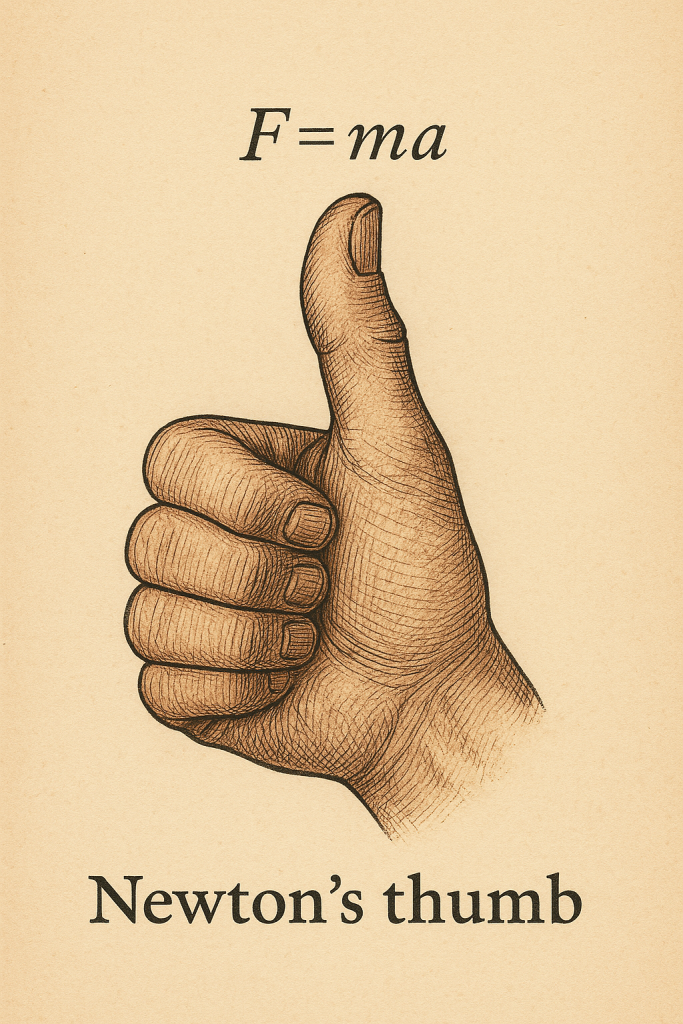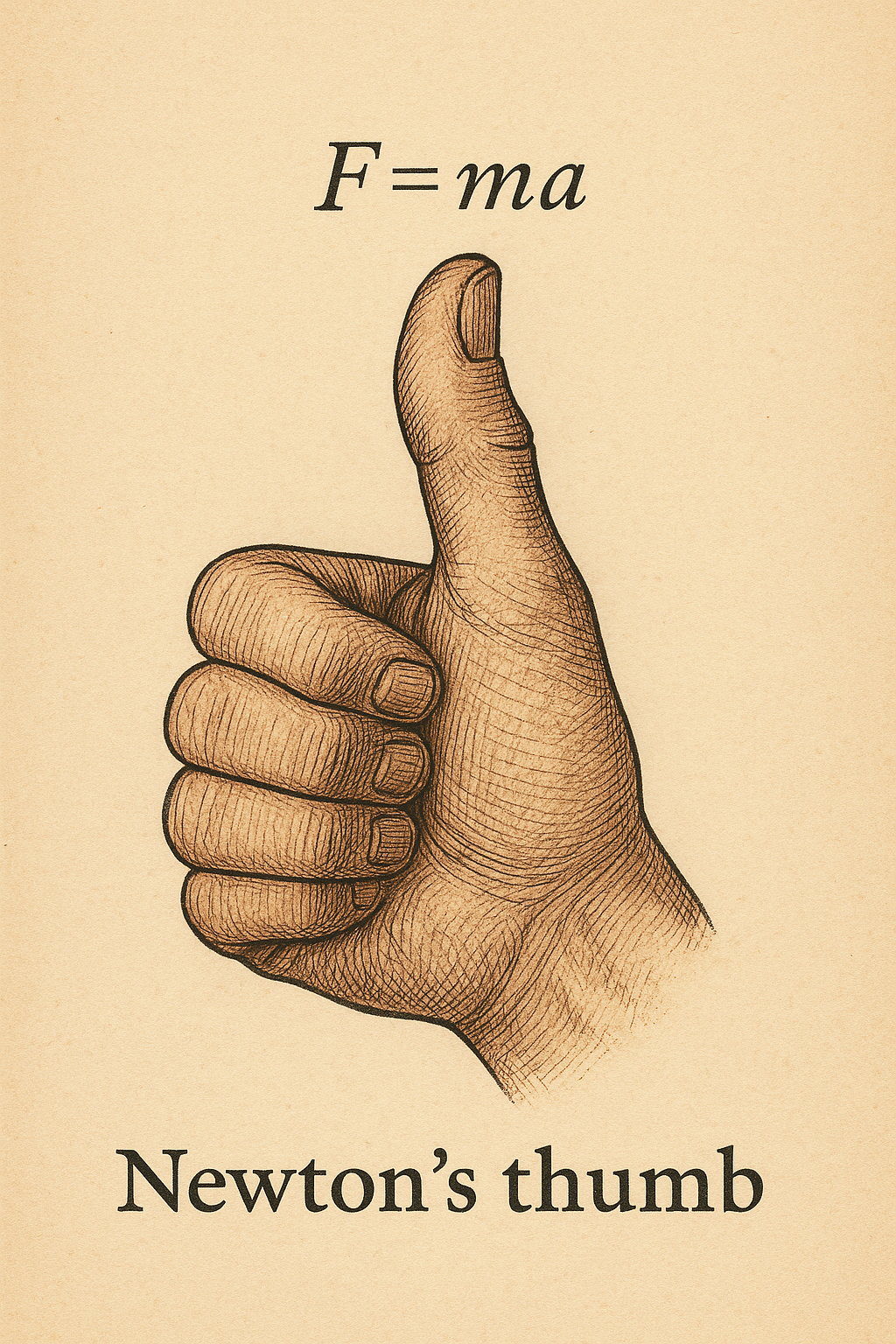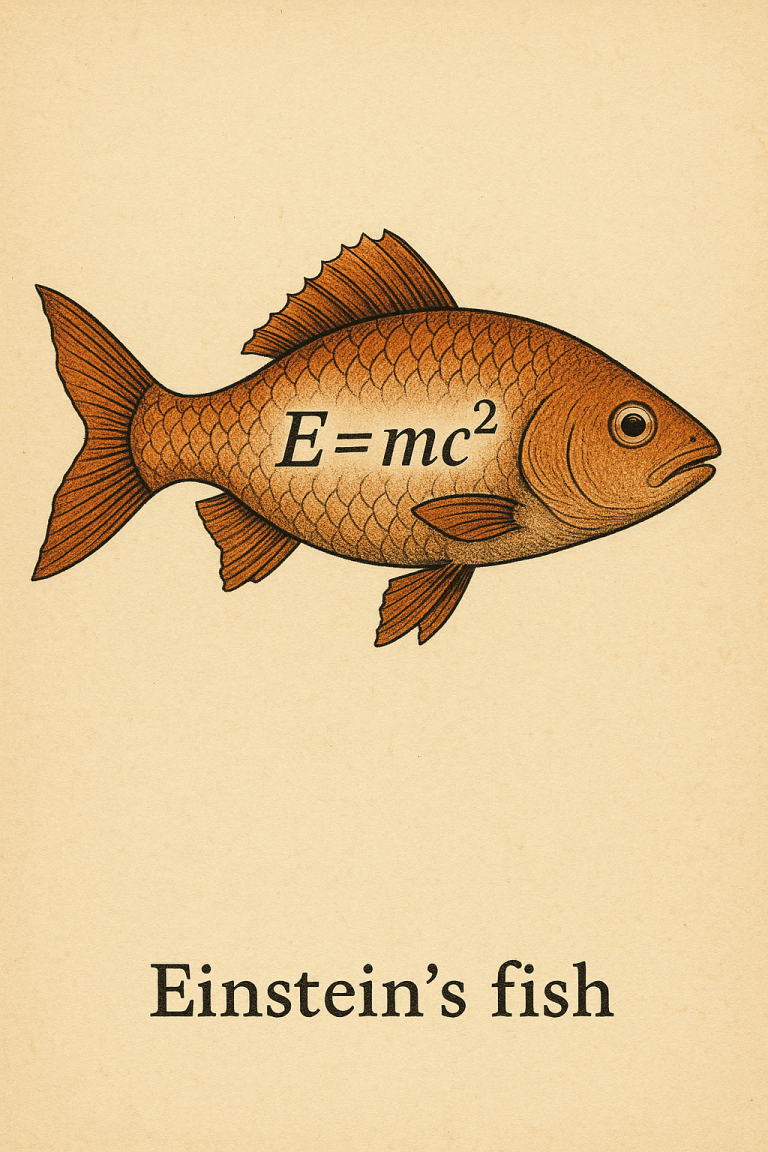Newton’s Thumb

Sacred Patterns: Reflections from the Theoretical Frontier – Part 3
Date: April 18th, 2025
Summary/Teaser: Falling inanimate objects and your thumb. What do they have in common? Newton knew—and his answer might just deepen both your faith and wonder.
Reflection:
If you dropped a penny and a 10-pound dumbbell off the Empire State Building at the exact same time (and removed air resistance) which one would hit the ground first?
While I don’t recommend testing this exact scenario, anyone who knows the right answer has probably brushed up on the teachings of Sir Isaac Newton at some point in their lives. Born in 1642, Newton is celebrated as one of the greatest minds to ever grace Earth and is branded into thousands of textbooks. His life’s work uncovered the fundamental physical laws that govern our planet, our solar system, and everything in between.
He was fascinated by how objects move and why the motion of one can ripple into another. (We saw this idea in week #1: even something as small as picking a flower nudges the rest of the universe, ever so slightly.)
But Newton wasn’t just a scientist. He had a rare gift for turning complex ideas into clean, usable math. Thanks to his work, today we can calculate the arc of a buzzer-beating shot in March Madness, determine the thrust needed to launch a rocket into orbit, and settle the debate of whether a dumbbell or a penny hits the ground first. His influence reaches from the basketball court to the edge of space.
Newton was absolutely brilliant… and also a little unhinged in the best mad-genius way possible. In his quest to understand the properties of light, he would stare at the sun for a full day, following its course over the sky, then later record the afterimages and damage—and yes, he had to spend days in a dark room to recover his sight. He would become so immersed in his studies that he would sometimes forget to eat for days. And he once wrote an entire scientific manuscript in Latin, backwards, to prevent unworthy minds from reading it easily.
Yet, one of my favorite things about Newton isn’t found in his science-y quirkiness—it’s in his grander sense of wonder. Though he’s best known for studying the stars and unlocking the laws that tether them, Newton actually wrote more about theology than physics. Arguably the greatest physicist in history, the man who uncovered the universe’s most fundamental principles devoted much of his life to contemplating its Maker.
Newton was especially captivated by the books of Daniel and Revelation, believing that history unfolded according to a God-ordained pattern revealed through prophecy. His deeply personal writings on the matter remained mostly unpublished for centuries.
And then there’s this gem of a quote attributed to Newton that stops me every time:
“In the absence of any other proof, the thumb alone would convince me of God’s existence.” 👍
The thumb? Seriously?
A man who spent his life decoding the cosmos found his proof of God… in a thumb? That stubby little hinge of skin and bone? Newton’s discoveries stretched lightyears, but his best “proof” of God was only an armlength away?
Exactly.
That’s the kind of awe that powered Newton’s genius—the belief that even the smallest parts of us are stitched together with brilliance beyond measure.
In medical school, I spent months dissecting the human body—every inch of it—on the donated remains of people whose souls have already moved on. I’ve examined the inner folds of the brain, the chambers of the heart, the full length of the spinal cord. Yet, within that scenario, nothing felt more human than gently prying open a cold, contracted hand. I could relate to those hands. They’d once held a lover’s fingers, turned car keys, earned a living. They told a story. (I personally had a female cadaver with the knuckles on her hands destroyed by rheumatoid arthritis).
And what about the thumb? What I saw when I took a blade to it was a marvel of engineering. Within its fleshy pad are four compact muscles, each working in harmony. Tilt your hand, give that thumb a little wiggle—and suddenly a dozen more muscles and six bones join in. It’s a symphony of motion, performed inside a space no bigger than a matchbox. It senses pressure, pain, sharpness, weight, heat, even the sting of a bee—and when your eyes are closed, it still knows which way is up. Its tiny ridges and valleys form a topographic map that makes your fingerprint yours alone.
The opposable thumb—meaning it can cross the hand and reach the other fingers—is what helped our ancestors spark fire from flint, gripped Lincoln’s top hat and van Gogh’s paintbrush, and gave every politician, superstar, and pedestrian their identity… including the carpentry abilities of Jesus Christ. We use our thumbs thousands of times a day. They account for roughly 40% of our hand’s function—and no other creature in the animal kingdom comes close to matching our dexterity.
There are millions of species on Earth. Yet only humans have developed the fine motor control to guide a quill, strike a hammer, or use a scalpel. With these devices, only humans—God’s chosen ones—can write poetry, build cathedrals, or perform surgery—all thanks, in part, to the divine mechanics of the thumb.
Today, we often reduce the thumb to a tool for texting or gaming. But beneath your thumbnail are more than 50 billion living cells, working in perfect sync to make every motion happen. Your thumb is not just functional, it’s a miracle of divine craftsmanship.
And because of that, we ought to use it wisely. Use your thumbs to build, to bless, to send messages worth sending. Let your hands do work that honors the One who made them.
Now, to wrap up: if we were to open our hands—“un-oppose” our thumbs—and let that penny and dumbbell fall (from somewhere safe, of course), they’d hit the ground at the same time! Were you right?
That’s the beauty of how God designed the world: equality among all, even if we look nothing alike. A free weight and a coin, side by side. Newton wasn’t inventing this truth—he was simply uncovering the order that God had already written into creation.
So, this week, try it. If you’ve got kids or grandkids, drop two objects side by side from a second-story window and let them guess which hits first.
It’s a fun way to teach physics…and maybe a deeper kind of faith.
Your brother in Christ,

PS… You are loved beyond measure, always and forever.



